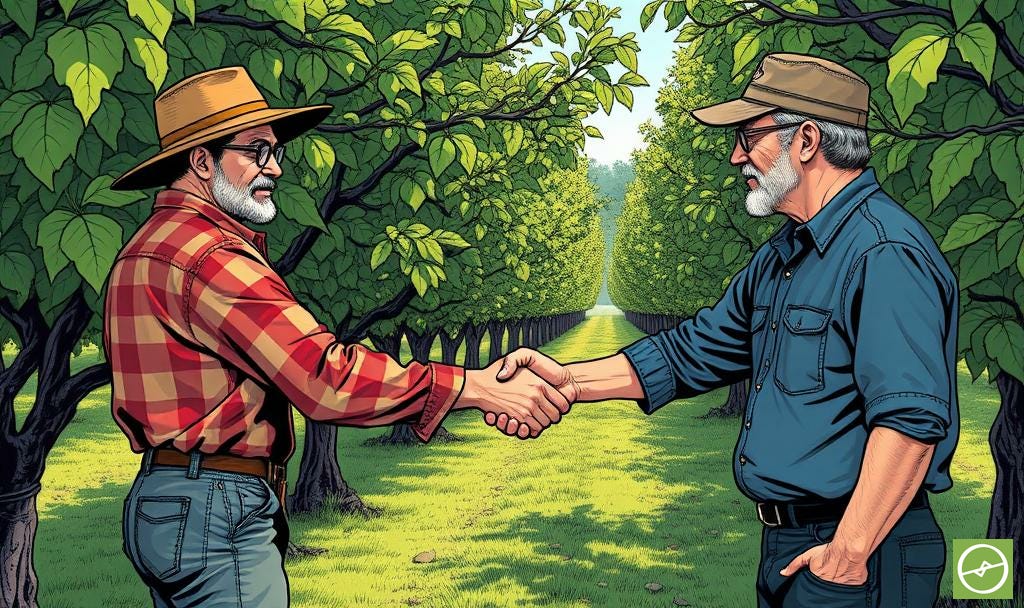Innovation in Agriculture: Why Relationships Trump Tech for Many Farmers
Why most farmers resist early tech adoption and why trust, relationships, and proof in the field matter more than sales pitches.
In a recent post I wrote about adaptability being a competitive advantage in farming. But one of my readers raised an important point:
“Not the farmer’s way though. They are not early adopters. Most. It remains a difficult market. Who you know sometimes more important than what you sell.”
And, in a way, they’re right.
We often talk about technology adoption in agriculture as if it’s a purely rational process: a farmer sees a better way, tests it, and if it works, they adopt it. But in reality, the uptake curve looks different. Very different.
Most Farmers Are Not Early Adopters
In every industry, there are early adopters; the ones eager to try something new. In agriculture, they exist, but they’re rare.
Most farmers sit firmly in the early majority or even late majority. They wait to see proof. They wait for neighbours to try it first. They want the risk (and the learning curve) to be someone else’s problem.
And given the stakes, who can blame them?
When margins are thin and a season’s work can be undone by a single storm, pest outbreak, or even market shift, “playing it safe” isn’t laziness; it’s often wise. It’s survival.
The Trust Economy of Agriculture
Here’s where the second part of that feedback comes in: “…who you know matters more than what you sell.”
Agriculture is a relationship business. Always has been. Whether you’re buying inputs, selling produce, or trialling new tech, trust is the real currency.
That’s why a farmer may choose a long-time supplier over a new, potentially better-value option. Why a neighbour’s recommendation carries more weight than a slick product brochure. And why technology companies often underestimate the importance of local, face-to-face credibility.
Bridging the Gap Between Innovation and Adoption
If we want to see quicker technology adoption in farming (whether a service provider, agronomist, or a fellow farmer) we need two things:
Proven results in a farmer’s own context
Global case studies are nice. But the real conversion happens when someone sees a neighbour, with the same soils, climate, and challenges, succeed.Relationships built over time
One-off demos rarely shift entrenched habits. Consistent presence, seasonal check-ins, and solving real problems (not just selling features) are what eventually move the needle. And developing solution enhancements based on feedback? A cherry-on-top move.
Technology Still Wins. But It Needs an Advocate
In the end, technology and innovation do change agriculture. But they rarely win alone. They win when carried by trusted voices. Agronomists, local champions, or peer-group farmers who’ve already walked the path, or leading the charge.
The challenge for innovators isn’t to prove their technology works. It’s to make sure that proof is delivered by someone the farmer already trusts.
Closing Thought:
Adaptability is still the winning trait in farming. But we can’t expect it to happen in isolation. If we want more farmers to embrace change, we have to work with the reality of how decisions are made. Where trust, relationships, and proven examples matter as much as the technology itself.
Want to Learn More?
If you’ve ever felt hesitant about trying new farming technologies or methods, you’re not alone. Many farmers prefer to see proof before making a change; and that’s perfectly reasonable. The key is finding ways to explore new ideas without risking your entire operation.
Below are 5 ready-to-use AI prompts you can paste into ChatGPT (or your preferred AI assistant) to get tailored advice for your situation.
“Analyse the risks and benefits of adopting [specific technology or practice] in my farming operation, considering my crop type, region, and budget.”
“Create a step-by-step plan for testing a new agricultural technology on a small part of my farm to reduce risk before full adoption.”
“Suggest low-cost ways I can start integrating precision farming tools without overhauling my current systems or workflows.”
“Explain real-world examples of farmers in [my crop/region] who successfully moved from traditional practices to modern innovations.”
“Identify the key relationships and trusted advisers I should cultivate to confidently evaluate and adopt new farming methods.”
FURTHER READING:
Check out this book, where I spell out a sure and tested way to find your “AgTech Bestie” via a simple set of Google Searches.
I go into detail - but keep it simple and practical - in my author chapter in Louis Jupp’s book titled, “Drone Profession 4”. An eclectic drone technology focused book encompassing 18 UAV professionals and their “current thinking on best practices and business success”.








